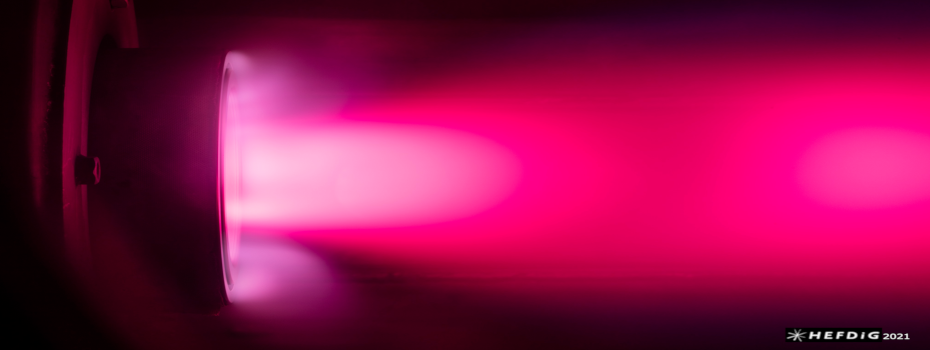Speaker
Description
Abstract
With the advancement of technology comes opportunities to review current tools and methods to see how they can be improved. Optical emissions spectroscopy (OES) is a vital tool used on many facilities due to its non-intrusive nature. It is especially useful on hypersonic impulse test facilities such as shock tubes and expansion tubes as it allows for the chemical composition of the test flow to be determined. Limitations on hardware have restricted the amount of data that can be recorded during tests due to short test times at these facilities. To increase the number of spectral frames taken by an OES system the exposure time must be shortened, leading to the possibility of the OES system not detecting low intensity emissions. To circumvent this issue an image intensifier can be placed in front of the camera. This project aims to create an ultra-highspeed OES system to allow for greater understanding of non-equilibrium flows like those encountered upon entry into planetary atmospheres.
Optical Emissions Spectroscopy System
The ultra-high speed emission spectroscopy system configuration to be developed in this project consists of a spectrometer with its output connected to a HiCATT 25 intensifier coupled with a V2012 Phantom camera. To ensure that the spectrometer exit focuses on the intensifier sensor, a diverging lens with a focal length of f=-100 mm was placed in an interface between the spectrometer and intensifier. The HiCATT 25 intensifier can increase sample rates up to 300 kHz or up to 2.5 MHz in bursts when synced with the Phantom camera.
The system will be utilised on hypersonic impulse tests focusing on Mars return conditions and giant planet atmosphere entry conditions to test the initial capabilities of the OES system. The main capability of the system is a frame rate of 100 kHz allowing for 10 frames of spectral data to be collected on a single test on X2, as opposed to the current single frame of spectral data. This system will be primarily tested on UQ’s X2 expansion tube.
Using the designed ultra-highspeed OES system, the electron number density of the flow can be determined and how the gas species dissociate and change in the flow as temperature increases can be tracked. The OES system will be most effective at studying the non-equilibrium flow experienced during both experiments and actual entry into atmospheres. By better understanding these non-equilibrium flow conditions of planetary atmospheres the unknowns and uncertainties would be reduced, increasing the likelihood of a successful mission. This would allow for better planning for future missions to and from planets in our solar system which is crucial for space travel. The system is currently being tested on the well-known atmospheric composition of Earth, where entry conditions from a Mars return mission will be simulated.
The HiCATT 25 image intensifier is capable of exposures as short as 3 ns. The HiCATT 25 intensifies light using two photocathodes with a diameter of 25 mm at its inlet which converts incoming photons to electrons. The photocathode material used for the HiCATT in the system is gallium arsenide phosphide (GaAsP). The efficiency of the conversion for each wavelength is defined by the quantum efficiency of the photocathode material. The specific HiCATT 25 has a 10\% quantum efficiency (QE) at a wavelength of 300 nm which increases to a maximum QE of 50\% at 500 nm before decreasing back to 1\% QE at 750 nm. This makes the HiCATT 25 most effective between wavelengths in the visible spectrum between 300 nm and 700 nm. The output of the HiCATT contains a screen layer of phosphorescent material upon which when the converted electrons make contact, the screen emits light. The phosphor used in the systems HiCATT outlet screen is P46. P46 has a decay time of 0.500 µs to 10\% brightness and 2 µs to 1\% brightness. This is important to factor in when setting the frame rate, as too high of a frame rate could lead to severe overlap of the sensor leading to stacking of images on the intensifier’s screen. The gain setting on the HiCATT can be set between 400 and 900 volts. The output wavelength of the intensifier is primarily in the green area of the visible spectrum (550 nm). The HiCATT 25 can be synchronised to the V2012 Phantom by connecting the Phantoms strobe connection to the HiCATT’s controller box’s sync in connection.
Results
During initial testing the ultrahigh-speed spectroscopy system performed well. Changes to the system setup to capture data of different spectral wavelengths regions and at different frame rates were done in software, making these changes simple to make. The amount of data collected is a vast improvement to the single frame of spectral data that is typically recorded for tests on X2. It was previously thought that the flow reached steady state and did not change during the test; however, it was observed that the emission intensity does change over the course of the test.
This was especially prominent in test x2s5098, the time-resolved intensity of emissions during these tests are seen in figure \ref{figure:9}. The emissions intensity rises after the OES system is triggered over roughly 30 µs before plateauing and dropping after the test gas has passed. This indicates that these types of high-speed spectroscopy systems are useful for observing dynamic changes in the flow, where previously it was not possible due to limitations in hardware and short test times on X2.
Summary
This abstract lays out an introduction to the new Ultra-Highspeed Optical Emission Spectroscopy System currently being developed at the University of Queensland's Centre for Hypersonics. It hope's to increase the capability of spectral data acquisition leading to a better understanding of how hypersonic impulse test facilities operate and improving their operation for better simulations.

